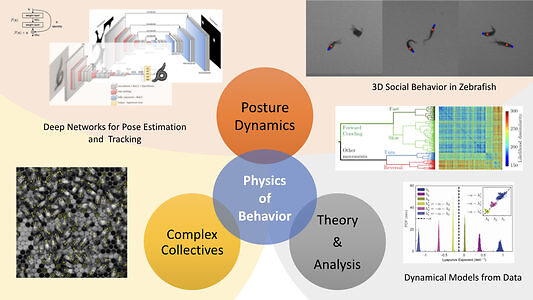Biological Physics Theory Unit (Greg Stephens)
The Biological Physics Theory Unit is pioneering a new field – the physics of behavior: from individual organisms to entire societies. While the science of the living world is mostly focused on the microscopic, such as the expression of genes or the pattern of electrical activity in our brains, all of these processes serve the greater evolutionary goals of the organism: to find food, avoid predators and reproduce. This is the behavioral scale, and despite it’s importance, our quantitative understanding of behavior is much less advanced. But how do we quantify the emergent dynamics of entire organisms? What principles characterize living movement? Research in our unit addresses these fundamental questions with a modern biophysics approach and model systems ranging from the nematode C. elegans to zebrafish and honeybee collectives. We combine theoretical ideas from statistical physics, information theory and dynamical systems and work in close collaboration with scientists from OIST and around the world to seek unifying principles form novel, quantitative experiments of organisms in natural motion.
Latest Posts
-
Unit PI Greg Stephens elected American Physical Society Fellow
The APS fellowship was awarded “for foundational contributions to the new field of the physics of animal behavior, and especially for understanding the statistical structure and the dynamics of behavior of a nematode, C. elegans.”
How can we use partial observations to infer ensemble dynamics directly from data?
See our work (including code and examples) on maximally-predictive states and Markov chain dynamics now published in Chaos!
APS DBIO Dissertation Award to Antonio Carlos Costa
A bit delayed with the news but very happy to report that Antonio Carlos Costa has won the APS DBIO award for outstanding doctoral thesis research in biological physics. Congratulations to Antonio who is now a Junior Research Chair postdoctoral researcher at the Ecole Normale Superieure in Paris.




